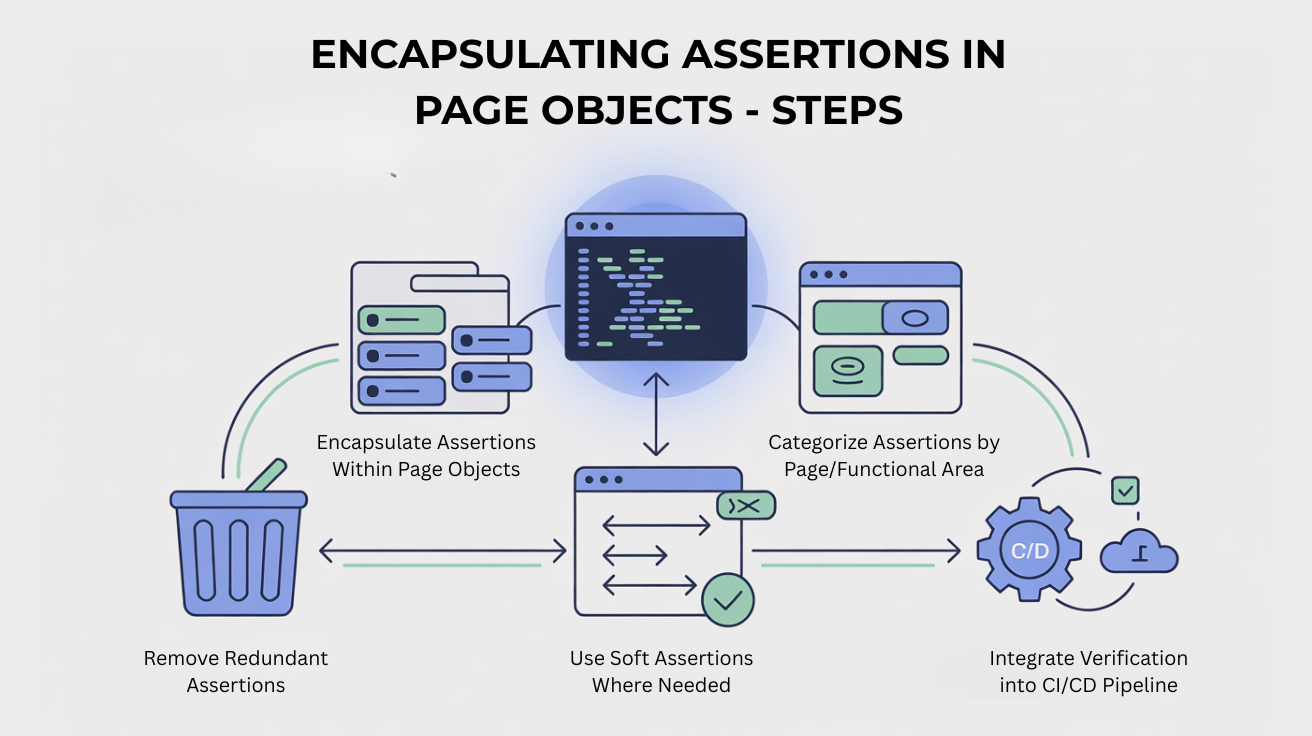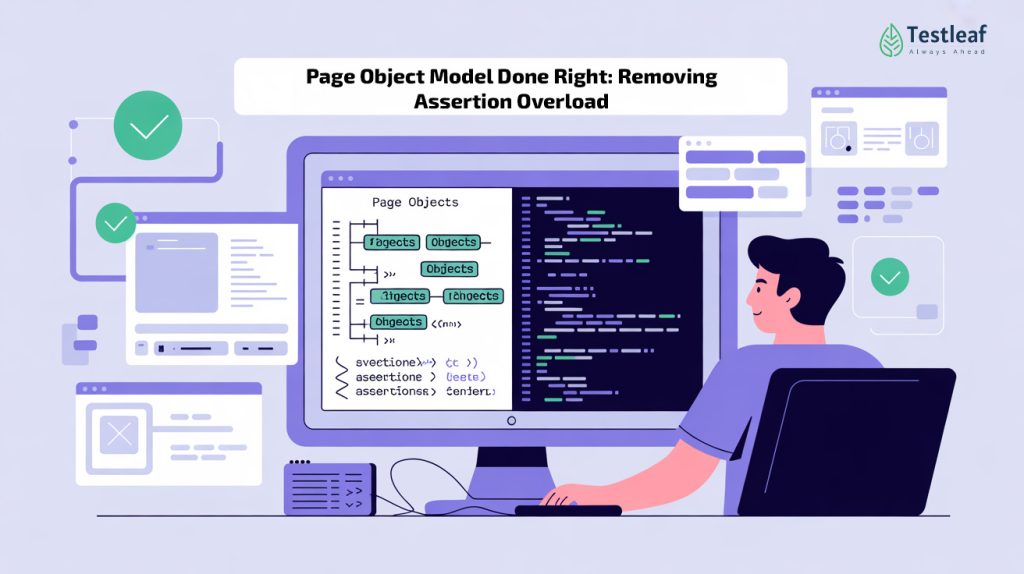When I first started my journey as a QA engineer, one of the things I quickly noticed was that our test scripts were messy, brittle, and hard to maintain. Each test case was filled with dozens of assertions, hard-coded locators, and repetitive code that made debugging a nightmare. I remember sitting through test runs that failed not because the application was broken, but because a single UI change broke ten different assertions.
It was in that chaos that we realized we needed a better approach. That’s when we decided to adopt the Page Object Model (POM)—but we didn’t just implement it blindly. We learned that POM is powerful only when done right, especially in tackling the problem of assertion overload. In this blog, I’ll share how we transformed our test framework, why removing assertion overload was critical, and the impact it had on our QA process.
The Problem: Assertion Overload
In our legacy framework, every test method was littered with assertions:
assertTrue(loginPage.isUsernameVisible());
assertTrue(loginPage.isPasswordVisible());
assertTrue(loginPage.isLoginButtonEnabled());
assertEquals(loginPage.getTitle(), “Login”);
At first glance, it seems thorough, right? But this approach had hidden consequences:
- High Maintenance Cost
Every small UI change required updating multiple assertions across hundreds of tests. Changing a button’s ID or label meant dozens of failures, many of which were irrelevant to the actual business scenario. - Poor Debugging Experience
When a test failed, we couldn’t immediately know which assertion was truly critical. Multiple failures in a single test caused confusion and wasted time, as developers and testers spent hours figuring out what really went wrong. - Reduced Test Reliability
Tests failed intermittently because of minor UI fluctuations or timing issues. Assertions like isVisible() or isEnabled() often triggered false negatives when a page element was slightly delayed in loading. - Cluttered Test Code
The more assertions we added, the harder it became to read and understand the test flow. It was almost impossible for a new tester or developer to quickly grasp what the test was supposed to validate.

It became clear: assertion overload was slowing us down and increasing technical debt.
Check Out These Articles: Epam interview questions
The Solution: POM Done Right
Page Object Model is a design pattern that encourages separating the test logic from the page structure, but simply creating page objects wasn’t enough. We had to rethink how assertions were used.
1. Encapsulate Assertions Within Page Objects
Instead of scattering assertions across test methods, we moved them into the page classes. For example, rather than asserting visibility in the test:
assertTrue(loginPage.isUsernameVisible());
We created a method inside LoginPage:
public void verifyLoginFormVisible() {
Assert.assertTrue(usernameField.isDisplayed(), “Username field is not visible”);
Assert.assertTrue(passwordField.isDisplayed(), “Password field is not visible”);
Assert.assertTrue(loginButton.isEnabled(), “Login button is not enabled”);
}
Now, in the test method, we could simply call:
loginPage.verifyLoginFormVisible();
This approach reduced assertion clutter in the test scripts and made the tests more readable. The test method now describes what it’s testing, not how it’s testing it.
2. Categorize Assertions by Page and Functional Area
We divided page objects into logical sections: form validation, button state, table verification, etc. Each section had its own verification methods. For example:
- LoginPage.verifyLoginFormVisible()
- DashboardPage.verifySummaryCardsDisplayed()
- AccountPage.verifyTransactionTableLoaded()
This organization allowed us to reuse assertion logic across multiple tests and maintain consistency. If the login form changed, we only had to update verifyLoginFormVisible(), instead of touching every test that checked login elements.
3. Remove Redundant Assertions
We audited our entire test suite and asked:
- Does this assertion directly validate the functionality we care about?
- Does this assertion overlap with another check already present?
We removed redundant checks, keeping only those that validated critical user flows. This step alone reduced the number of assertions in our framework by nearly 40%, significantly speeding up test execution and improving readability.

4. Leverage Soft Assertions Where Needed
In scenarios where multiple checks were necessary, we used soft assertions. This allowed the test to continue executing even if some assertions failed, collecting all failures at the end. The benefits were clear:
- Full view of all issues in a single test run
- Reduced false negatives due to minor UI timing issues
- Easier debugging and prioritization of actual business-impacting failures
5. Integrate Verification into CI/CD Pipeline
Once we cleaned up our assertion logic and refactored tests using POM, we integrated them into our CI/CD pipeline. With stable and meaningful assertions, the tests could run automatically in parallel across browsers without constant manual intervention. This made our daily sanity and regression testing more reliable and freed testers to focus on new features and exploratory testing.
Further Reading: Epam interview questions
The Impact of Doing POM Right
Refactoring our framework and removing assertion overload brought immediate benefits:
- Stable and Maintainable Tests
Test scripts became easier to read, maintain, and extend. Page objects served as a single source of truth for UI structure and functional validation. - Faster Debugging
When a test failed, the failure pointed directly to the core issue, not a cascade of redundant assertions. Developers appreciated this, and collaboration between QA and Dev became smoother. - Improved Execution Speed
Reducing the number of assertions and cleaning up redundant checks decreased test run time, especially when running hundreds of tests in parallel. - Reusable Verification Methods
Common verification methods were reused across multiple tests, reducing code duplication and enhancing consistency. - Better Test Reports
Test reports became cleaner, highlighting real issues instead of overwhelming everyone with assertion noise.

Explore More: automation testing interview questions
Lessons Learned
- Assertion Overload is Hidden Technical Debt
It’s easy to think more assertions mean better coverage, but too many assertions can obscure real failures and increase maintenance costs. - POM Is Not Just About Locators
The true power of Page Object Model comes when assertions and verifications are encapsulated within page objects, making tests more expressive and maintainable. - Quality over Quantity
Focus on meaningful, reusable, and critical assertions. This reduces test noise, improves debugging, and strengthens the overall framework.
Conclusion
Moving from assertion-heavy scripts to a well-structured Page Object Model transformed our QA process. By removing assertion overload, we made our tests more readable, maintainable, and resilient. Our automation framework became a reliable ally, not a fragile liability, allowing us to scale QA with confidence in a CI/CD-driven DevOps environment.
For any QA team struggling with brittle tests and assertion chaos, my advice is simple: refactor, encapsulate, and remove noise. Done right, Page Object Model doesn’t just organize your code—it elevates your entire automation game.
FAQs
1. What causes assertion overload in test automation?
Assertion overload happens when dozens of assertions are written in a single test, leading to cluttered scripts, false failures, and difficult debugging. It often appears in frameworks lacking structure or when assertions aren’t grouped logically.
2. How does Page Object Model reduce assertion overload?
POM groups UI actions and verifications inside page classes. By moving assertions into reusable verification methods, duplicate and scattered assertions disappear, improving readability and maintainability.
3. Should I use hard or soft assertions in POM?
Use hard assertions for critical failure points where the test cannot continue. Use soft assertions when multiple UI checks are required and you want to capture all failures in one go.
4. Does POM help new testers onboard faster?
Yes. POM organizes locators, methods, and verifications cleanly, making it easy for new contributors to understand the flow without digging through complex test methods.
5. Can POM work with Playwright, Selenium, and Cypress?
Yes — POM is a design pattern, not a tool feature. It works across frameworks like Selenium, Playwright, and Cypress.
We Also Provide Training In:
- Advanced Selenium Training
- Playwright Training
- Gen AI Training
- AWS Training
- REST API Training
- Full Stack Training
- Appium Training
- DevOps Training
- JMeter Performance Training
Author’s Bio:

Content Writer at Testleaf, specializing in SEO-driven content for test automation, software development, and cybersecurity. I turn complex technical topics into clear, engaging stories that educate, inspire, and drive digital transformation.
Ezhirkadhir Raja
Content Writer – Testleaf








